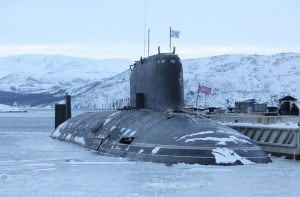The Russian Navy is reportedly expediting test launches of the hypersonic 3M-22 Tsirkon or Zircon anti-ship missile (ASM) from submarines and surface combatants, according to two Russian defense industry sources.
“The schedule of the hypersonic missile’s test launches from naval ships will be tightened,” the sources were quoted as saying by TASS news agency on March 25. “The Yasen submarines will begin firing drills this year, alongside the continuing series of launches from the Admiral Gorshkov.”
The Project 855 Yasen-class multipurpose nuclear-powered attack/cruise missile submarine (SSN/SSGN) K-329 Severodvinsk will reportedly be the service’s first boat to test fire the Tsirkon ASM.
“As part of the continued state trials of the Tsirkon shipborne missile system, the hypersonic missile’s firings are planned from the submerged position from the submarine Severodvinsk,” another Russian defense industry source was quoted as saying on March 11 by the TASS news agency.
The Navy reportedly intended to launch the Tsirkon not from the Severodvinsk, but from the service’s first-of-class Project 885-M SSN/SSGN Kazan initially. However, the boat is now not expected to enter service until 2021. In December 2018, I wrote about the technical characteristics and armament of the two Yasen-class variants:
The improved Yasen M-class SSN is reportedly quieter than the lead Yasen-class boat. It is built with low magnetic steel to reduce its magnetic signature. The Yasen M-class SSN is purportedly not equal to the United States Navy’s new Virginia–class attack subs. Rather it is technically on par with older U.S. Seawolf-class SSNs, built by the U.S. Navy from 1989 to 2005, although the underwater top speed of the Russian subs is reportedly much lower than that of U.S. boats.
The Kazan is fitted with eight vertical СМ-346 complex (3Р-14В) silos for submarine-launched cruise missiles as well as 10 torpedo tubes for firing (…) [missiles and torpedoes]. The Severodvinsk can carry up to 40 Kalibr cruise missiles while (…) the Kazan, can carry 32. (The Kazan is approximately 10-12 meters shorter than the first boat.)
The Tsirkon hypersonic missile was reportedly already test fired from the Project 22350 frigate Admiral Gorshkov in January of this year. The missile was launched from the Barents Sea against a ground target at a distance of 500 kilometers in the Northern Urals. As I explained last month:
The Tsirkon hypersonic ASM is thought to be a variant of the P-800 Onyx ASM. The P-800 has a reported maximum speed of March 2.9 and a maximum range of up to 500 kilometers, while the Tsirkon, powered by a solid-propellant boost engine and supersonic combustion ramjet (scramjet), is thought to be capable of hitting targets at a distance of up to 1,000 kilometers. The longer range is reportedly partially due to a new fuel, Detsilin-M, specially designed for hypersonic cruise missiles.
The Russian defense minister, Army General Sergei Shoigu, also told Russian lawmakers last month that “flight development tests of the Tsirkon sea-launched hypersonic missile are under way” without revealing specific launch dates.

































